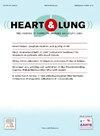Validity and reliability of the thirst distress scale and the short version of the xerostomia inventory for use in German patients with chronic heart failure: A multicenter cross-sectional study
IF 2.4
4区 医学
Q2 CARDIAC & CARDIOVASCULAR SYSTEMS
引用次数: 0
Abstract
Background
Thirst and xerostomia are prevalent and distressing symptoms in patients with chronic heart failure (CHF). Evaluation of interventions to alleviate these symptoms requires valid and reliable instruments. Such instruments are currently lacking for German patients with CHF.
Objectives
The purpose of this study was to evaluate the structural and convergent validity, and internal consistency reliability of the German versions of the Thirst Distress Scale for Patients with Heart Failure (G-TDS-HF) and the short form of the Xerostomia Inventory (G-SXI).
Methods
A cross-sectional, multicenter study was conducted involving patients with CHF. Participants completed a questionnaire containing the G-TDS-HF, G-SXI, and a visual analog scale (VAS) to indicate intensity of thirst and xerostomia. Exploratory and confirmatory factor analyses were conducted to assess structural validity. To assess internal consistency reliability, McDonald's Omega total was calculated, and Pearson´s r was used to examine convergent validity.
Results
A total of 371 patients (62.4 (± 14.9) years, 28.3 % female) participated in the study. Factor analysis of the G-TDS-HF revealed a two-factor structure. One factor represents symptom occurrence, and the second factor is symptom distress. Internal consistency reliability was deemed adequate, with McDonald's Omega total coefficients of 0.81. The correlation between the sum scores of the G-TDS-HF and thirst intensity (VAS) was r = 0.44 (p < 0.001). The G-SXI demonstrated a single-factor structure with a McDonald's Omega total of 0.71. The correlation between the G-SXI and xerostomia intensity (VAS) was r = 0.36 (p < 0.001).
Conclusion
Results suggest that the G-TDS-HF and the G-SXI are valid and reliable instruments. Further research is warranted to assess responsiveness and test-retest reliability to strengthen the evidence.
用于德国慢性心力衰竭患者的口渴痛苦量表和口干症清单短版的有效性和可靠性:一项多中心横断面研究
背景口渴和口干症是慢性心力衰竭(CHF)患者普遍存在的痛苦症状。评估缓解这些症状的干预措施需要有效可靠的工具。本研究的目的是评估德文版心力衰竭患者口渴压力量表(G-TDS-HF)和口干症状量表简表(G-SXI)的结构效度、收敛效度和内部一致性效度。参与者填写了一份包含 G-TDS-HF、G-SXI 和视觉模拟量表(VAS)的调查问卷,以显示口渴和口干症的强度。为了评估结构有效性,我们进行了探索性和确认性因子分析。为评估内部一致性可靠性,计算了麦克唐纳欧米茄总值,并使用皮尔逊r检验了收敛效度。结果共有371名患者(62.4(±14.9)岁,28.3%为女性)参加了研究。G-TDS-HF 的因子分析显示出双因子结构。一个因子代表症状发生,第二个因子代表症状困扰。内部一致性可靠性被认为是充分的,麦当劳欧米茄总系数为 0.81。G-TDS-HF 总分与口渴强度(VAS)之间的相关性为 r = 0.44(p < 0.001)。G-SXI 显示出单因素结构,麦当劳欧米茄总分为 0.71。结论结果表明,G-TDS-HF 和 G-SXI 是有效可靠的工具。有必要开展进一步研究,以评估响应性和重复测试可靠性,从而加强证据。
本文章由计算机程序翻译,如有差异,请以英文原文为准。
求助全文
约1分钟内获得全文
求助全文
来源期刊

Heart & Lung
医学-呼吸系统
CiteScore
4.60
自引率
3.60%
发文量
184
审稿时长
35 days
期刊介绍:
Heart & Lung: The Journal of Cardiopulmonary and Acute Care, the official publication of The American Association of Heart Failure Nurses, presents original, peer-reviewed articles on techniques, advances, investigations, and observations related to the care of patients with acute and critical illness and patients with chronic cardiac or pulmonary disorders.
The Journal''s acute care articles focus on the care of hospitalized patients, including those in the critical and acute care settings. Because most patients who are hospitalized in acute and critical care settings have chronic conditions, we are also interested in the chronically critically ill, the care of patients with chronic cardiopulmonary disorders, their rehabilitation, and disease prevention. The Journal''s heart failure articles focus on all aspects of the care of patients with this condition. Manuscripts that are relevant to populations across the human lifespan are welcome.
 求助内容:
求助内容: 应助结果提醒方式:
应助结果提醒方式:


